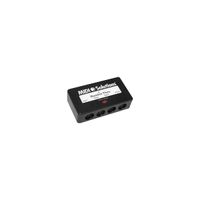The RF HDMI modulator is a device that allows you to convert an HDMI signal into an RF (Radio Frequency) signal. It is commonly used in situations where you want to distribute HDMI video and audio signals over a coaxial cable system, such as in cable TV networks, satellite systems, or older TV systems that do not have HDMI inputs.
The modulator takes the HDMI input from a video source, such as a Blu-ray player, game console, or set-top box, and converts it into an RF signal that can be received and tuned in by televisions or other devices connected to the coaxial cable network.
Here's how the RF HDMI modulator typically works:
- Input: You connect the HDMI output of your video source to the HDMI input port on the modulator. This could be a Blu-ray player, DVD player, gaming console, or any other device with an HDMI output.
- Encoding: The modulator encodes the HDMI signal into an RF signal, usually using a specific channel frequency that can be tuned in by the receiving devices. This encoding process compresses the HDMI signal into a format suitable for transmission over a coaxial cable.
- Output: The modulator outputs the RF signal through a coaxial cable connection. You would then connect this output to the cable network, where it can be distributed to multiple TVs or other devices that can receive RF signals.
- Tuning: The TVs or other receiving devices connected to the coaxial cable network can then tune in to the specific channel frequency assigned by the RF HDMI modulator to receive and display the HDMI signal.
The RF HDMI modulator does not convert the HDMI signal into an analog signal. Instead, it converts it into a digital RF signal that can be distributed over a coaxial cable system. This allows you to use existing coaxial cable infrastructure to transmit HDMI signals to multiple displays or devices without the need for individual HDMI cables.
How To Use The Modulator Rf Hdmi
Here's a step-by-step guide on how to use Modulator Rf Hdmi:
- Connect the HDMI Source: Start by connecting the HDMI output of your video source (e.g., Blu-ray player, gaming console) to the HDMI input port on the RF HDMI modulator. Use a high-quality HDMI cable for optimal signal transmission.
- Set Channel Frequency: Determine the desired channel frequency for the RF signal. Most RF HDMI modulators allow you to select or configure the channel frequency. Ensure that the frequency you choose is compatible with the receiving devices and doesn't interfere with other nearby channels.
- Connect Coaxial Cable: Connect the RF output of the modulator to the coaxial cable system. Use an appropriate coaxial cable and ensure a secure connection. This cable will transmit the RF signal to the TVs or other receiving devices.
- Configure Modulator Settings: Access the modulator's settings menu, typically through a remote control or front panel buttons. Set the desired output parameters, such as channel frequency, modulation type (e.g., QAM), and signal strength. Consult the modulator's user manual for specific instructions on configuring these settings.
- Connect Receiving Devices: Connect the TVs or other devices that will receive the RF signal to the coaxial cable network. Ensure that the devices have built-in RF tuners or use external RF tuners to receive the modulated HDMI signal.
- Tune-In Channels: On the receiving devices, scan for available channels or manually tune to the frequency set by the RF HDMI modulator. Once tuned, the devices should be able to display the HDMI signal transmitted through the RF network.
Pro Tips:
- Check Compatibility: Before purchasing an RF HDMI modulator, ensure that it is compatible with your specific video source and receiving devices. Verify the supported resolutions, HDMI versions, and signal formats to avoid any compatibility issues.
- Signal Quality: To ensure the best picture and audio quality, use high-quality HDMI cables and coaxial cables. Poor-quality cables can introduce signal degradation and result in a lower-quality viewing experience.
- Interference Considerations: Take into account potential interference from other nearby channels or RF devices. Choose a channel frequency that minimizes interference and optimizes signal strength and clarity.
Always refer to the specific instructions provided with your RF HDMI modulator for detailed setup and configuration guidance.













